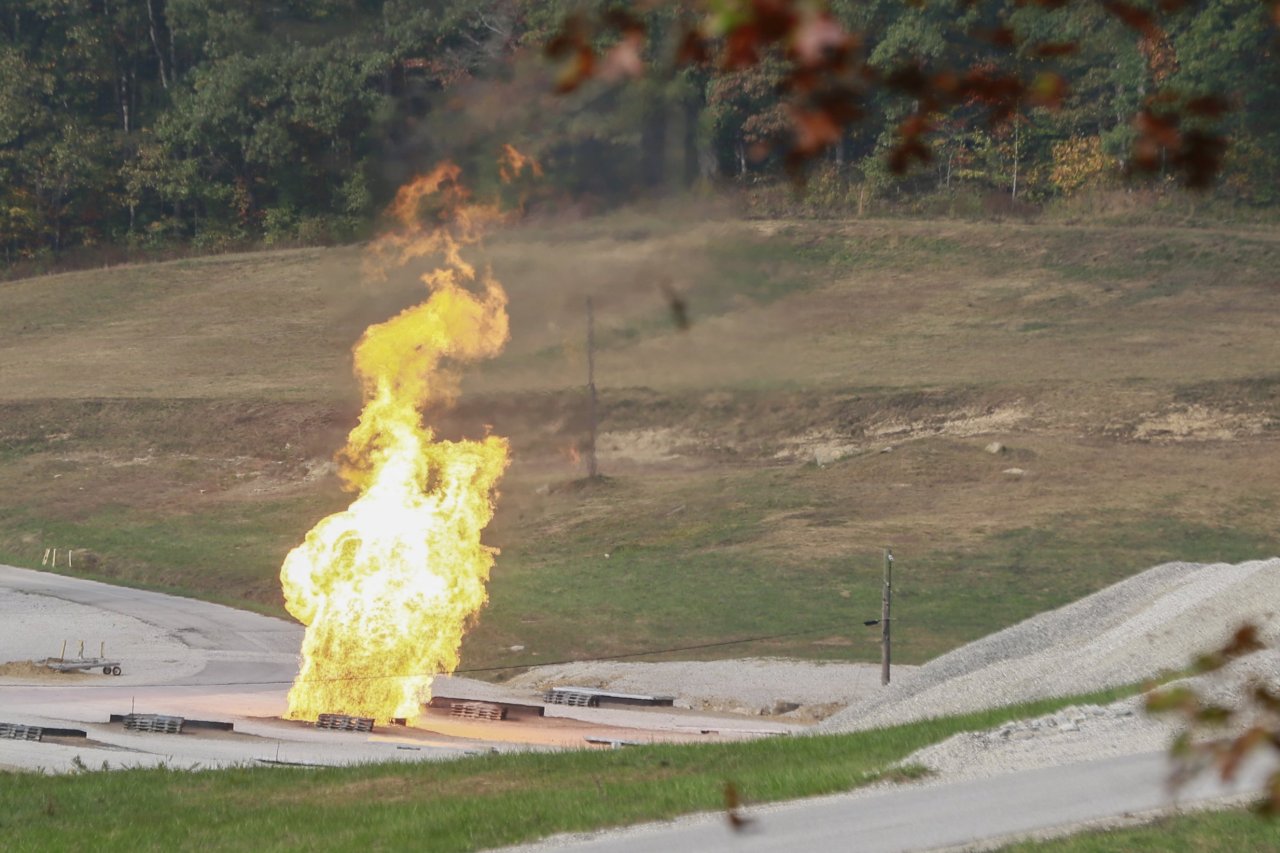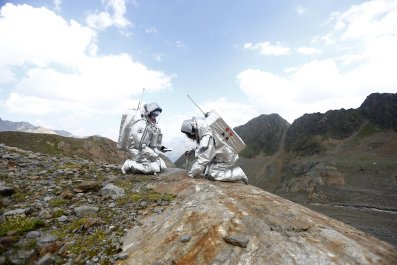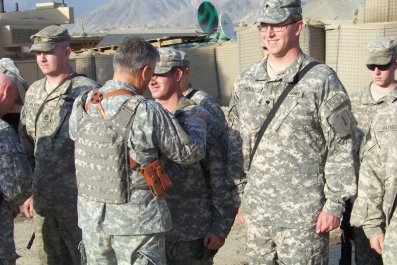This article first appeared on FairWarning.org
Two years ago, after Erin Card moved within two miles of the Radford Army Ammunition Plant in southwest Virginia, she began noticing threads of smoke that occasionally rose above the heavily wooded site. She started asking about the source, and was stunned by what she learned: Toxic explosives were being burned in the open air. "It just seems crazy to me," says Card, 36.
There is no proof that the fumes have harmed Card's family, which has lived in the Radford area for more than a decade. Yet her husband has suffered from cancer (he's now in remission), and the eldest of their young boys, 5-year-old Rex, had a cyst by his thyroid removed. "Sometimes," Card says, "I feel sick to my stomach with worry."
The open burning and detonation of hazardous waste explosives is banned in many countries, including Canada, Germany and the Netherlands. And in the United States, private industry long ago abandoned the primitive disposal practice, which is blamed for toxic air, soil and water pollution.
But the U.S. military and Department of Energy have been allowed to continue the open burning and detonation of explosives and, in a few cases, even radioactive wastes under a 1980 exemption from the Environmental Protection Agency. The EPA granted the exemption to provide time to develop better disposal techniques. Yet today, the U.S. allows open burning and detonation in at least 39 locations, according to federal data. That includes 31 military sites, at least five Department of Energy operations and one private business that handles wastes for the Department of Defense.
The government also continues the practice in Guam and the Puerto Rican island of Vieques, where open detonation, practice bombing and weapons development have fueled controversy for more than 60 years.
Related: Why the EPA is allowing contaminated groundwater to go untreated
"It's crazy that in the 21st century, they're still allowed to do it," says Marylia Kelley, executive director of Tri-Valley CAREs, an environmental watchdog group monitoring the cleanup of an open burn site at the Lawrence Livermore National Laboratory in Northern California. Developers hope to begin construction soon on thousands of homes within a mile of the open burn site at Lawrence Livermore—which, Kelley argues will expose residents to a range of toxic emissions. "It's an extremely crude technology," she says.
The EPA, which didn't respond to repeated requests for comment for this story, allows the open burning of waste explosives if it won't bring "unsafe releases" into the surrounding environment. But burning and detonating explosives in the open appear to do just that. In a presentation he gave last year to fellow agency employees, Ken Shuster, a veteran EPA expert in hazardous waste disposal, described the "tremendous amount" of air, soil and groundwater contamination caused by open burning.
In fact, the open burning of explosives routinely releases some of the most potent known toxins, including the carcinogens cadmium and dioxins, according to Brian Salvatore, a Louisiana State University expert on toxic emissions. "There's a whole assortment of them, and it's really awful," he says.
In an email, Army spokesman Wayne V. Hall said the Defense Department has reduced its use of open burning and open detonation and is evaluating new technologies to cut back further. Hall says the department uses open detonation in emergencies, when its officials determine munitions are unsafe for storage or transport and when no other option exists because of the munitions' "size and explosive content."
The latest defense spending bill included an amendment requiring the National Academy of Sciences to study alternatives to open burning. Senator Tammy Baldwin, a Democrat who helped push through the amendment, has long championed the cleanup in her home state of Wisconsin at the Badger Army Ammunition Plant, which used to conduct open burning. "This will ensure that other sites are not contaminated the way that the Badger site was," Baldwin wrote in an email.
But some believe the National Academy's study—to be completed by June 2018—is mere foot-dragging, since alternatives such as contained incinerators have long been available, and the Defense Department has faced calls to use them for decades. As far back as 1991, the EPA told the Pentagon that "safe alternatives" to open burning and detonation "can and should be developed." In 1997, Congress told the Defense Department to move ahead with environmentally clean disposal methods for munitions, rockets and explosives within five years, but little came of it.
Pentagon officials often argue that open burning is cheaper than the alternatives. But the EPA's Shuster says it is a "myth" when you factor in the environmental cleanup costs—sometimes hundreds of millions of dollars—at open burn sites. "We're finding that's it not so cheap if you include the total costs," he told his colleagues in his presentation.
Ted Prociv, former deputy assistant to the Secretary of Defense for chemical and biological matters, says the military should be conducting practical tests using alternative disposal systems already available and then deciding on whether to ban open burning and detonation. Prociv is currently a project coordinator for one such system, the Davinch detonation chamber, which he says was used to dispose of chemical weapons in Japan as far back as 1992. A ban, Prociv says, is "the only thing that's going to get these guys to do anything."
Doing something is imperative, Prociv says, because the munitions stockpile needing to be destroyed is staggering. According to a recent Government Accountability Office report, the total as of February 2015 was 529,373 tons. The Pentagon estimates that from fiscal year 2016 to fiscal year 2020, another 582,789 tons will be added.
Part of that stockpile sits at the Blue Grass Army Depot near Richmond, Kentucky. The base issues news releases to alert surrounding residents before any open burning or detonation takes place. Many can hear the blasts can from miles away. Among them: Craig Williams, program director of the Kentucky Environmental Foundation. "When you start hearing things blowing up, theoretically you're supposed to be prepared," he says.
An opponent of open burning who previously campaigned for the Defense Department to dispose of chemical weapons safely, Williams says a "monstrous" legislative quagmire awaits anyone challenging the practice, given the long-standing resistance to change and the polarized politics in Washington.
But the consequences of inaction could be dire. The EPA's Shuster, in his recent presentation, described "unbelievable" high levels of toxic groundwater contamination from the open burning of explosives, involving chemicals such as RDX, TNT and perchlorate. He said the contaminants, all linked to human health problems, in some cases have penetrated drinking water systems.
As for the toxic air emissions, LSU's Salvatore said they sometimes aren't properly monitored. He said that's partly because the most sophisticated technologies to detect fine particulates are rarely used, and also because the emissions are very widely dispersed. "You have no stack or chimney to concentrate the focus of the emissions. They just go willy-nilly everywhere," he said.
Inadequate air and groundwater monitoring can extend beyond the perimeter of bases as well, sometimes making it difficult to verify the source of toxic contamination in surrounding areas. Perchlorate, for example, is a contaminant released through open burning at the Radford Army Ammunition Plant in southwest Virginia. Nearby drinking water supplies are contaminated with perchlorate. Although plant officials say it's unlikely the problem comes from open burning, they acknowledge that it hasn't been "determined definitively."
A dearth of data makes it hard to prove any definitive links between open burning and chronic health problems among nearby residents. A 1991 Boston University study found that people living near a former open burn site in Massachusetts had higher than expected rates of lung cancer and that a causal link to open burning was possible.
Some suspect that chronic health problems suffered among soldiers who worked at burn pits in Afghanistan and Iraq is related to their exposure to toxic substances—an argument made by Joseph Hickman in his 2016 book, The Burn Pits: The Poisoning of America's Soldiers. But conventional explosives being burned in the U.S. are merely one type of the hazardous materials—including gasoline, pesticides, medical wastes, animal and human carcasses and possibly chemical weapons—that were destroyed in those war zones. The Department of Veterans Affairs is still studying the long-term health effects from exposure to these sites.
The lasting environmental impact from some open burning, however, is difficult to dispute. At Wisconsin's Badger Army Ammunition Plant, which stopped open burning in 1996, hundreds of monitoring wells track miles of groundwater pollution. Large groundwater plumes contaminated with chemicals such as DNT and chlorinated solvents from two former burn sites there still flow into the Wisconsin River, according to the Army's monitoring well data. "The Army said that they're going to be out here for decades monitoring the groundwater," said Laura Olah, executive director of Citizens for Safe Water Around Badger.
A spokesman for Badger, Mike Sitton, confirms the groundwater monitoring will continue for decades because the Army is using a passive process known as monitored natural attenuation to break down the contaminants naturally. He said the monitoring ensures that there will be little risk to public health.
Occasionally, open burning and detonation has proven controversial enough to prompt shutdowns. That was the case at the Sierra Army Depot in Northern California, where powerful blasts rattled the windows of nearby homes. In 1999, the depot was the second-worst source of toxic chemicals in all of California, according to EPA data. Local residents and environmentalists fought back by suing, and reached a settlement in 2001 that limits the Army to open burn or detonate munitions only in an emergency.
Public pushback also shut down open burning at the former Louisiana Army Ammunition Plant, now known as Camp Minden. Plans to open burn some 15 million pounds of M-6 propellant provoked uproar, forcing the plant two years ago to instead install a contained burn system to incinerate the stockpile. (Now that the incineration of the waste explosives is nearly complete, the contained burn system also is due to be shut down and removed, following a campaign by local activists to prevent Camp Minden from becoming a long-term disposal site.)
But incinerators won't single-handedly solve the problem of emitting dangerous chemicals, experts say, as some still emit dangerous chemicals such as dioxins, furans and nitrogen oxides. Makers of alternative disposal technologies, like the Davinch detonation chamber, argue that their systems are necessary to dispose of munitions when incinerators can't do it cleanly. Still, the technology behind incinerators is advancing fast. For example, the emissions from the incinerator at Camp Minden were, according to the system's operators, cleaner than the ambient air.
Incinerators are one of the options being reviewed at the Holston Army Ammunition Plant in Kingsport, Tennessee, where smoke from open burning has clouded the skies since the 1940s. A 2012 Army Corps of Engineers report identified two alternative disposal methods that can be used to destroy "all present and future wastes" at Holston, but the Army still is "pursuing alternative technologies," said Justine Barati, a spokeswoman for the Defense Department's Joint Munitions Command.
For Mark Toohey, a 61-year-old juvenile court judge whose hometown is nearby Kingsport the smoke seemed like no more than a minor nuisance for decades. In fact, he didn't even know whether it was coming from Holston or from one of the region's heavy-polluting plants. But five years ago, when the plumes started getting thicker and darker, Toohey was horrified when he finally learned that the source was toxic explosives being burned in the open air at the military site.
Toohey, who lives a mile and a half from Holston, blames the smoke for triggering the chronic asthma and severe sinusitis that his wife suffers. Their daughter, who lives close by, has similar health issues.
Now, when the fires burn on base, the Tooheys shut themselves inside and close all of the doors and windows. He can't believe the Army allows this environmental hazard to continue. "What," he asks, "does this say about how caring they are about the people around these sites, including their own employees?"
This story was reported by FairWarning, a nonprofit news organization based in Pasadena, California, that focuses on public health, consumer and environmental issues. It has been updated so that the version that appeared in the print magazine now also appears online.


















